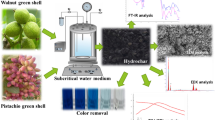Abstract
The properties of waste shells, which cause pollution problems, are investigated in Southern beach, Korea. The absorbent surface area was affected by the contaminant gas removal efficiency of the waste shell absorbents, pore structures, absorbent deliquescence and hygroscopicity during the contaminant gas reaction. The BET surface area of calcination/hydration waste shell and limestone samples was increased by hydration in isothermal conditions. The absorption rate with acid gas is predicted by apparatus for measuring the hydration rate. The BET surface area of waste shell samples hydrated at 90 ‡C isothermal condition was greatly increased. And pore size distribution and diameter were increased after calcination/hydration reaction. Waste seashells can be regarded as a good absorbent for removing acid gases. Therefore, the recycling of waste seashells as a substitute for limestone would be profitable. Key words:Waste Shell, Absorbent, Hydration Rate, Flue Gas Desulfurization
Similar content being viewed by others
References
Acharya, P., DeCicco, S.G. and Novak, R.G., “Factors that Can Influence and Control the Emissions of Dioxins and Furans from Hazardous Waste Incinerators,”J. Air Waste Manage. Assoc.,41(12) (1991).
Breault, R.W., Litka, A. F., Beittel, R. and Darguzas, J.N., “SO2 Control in Low Emissions Boiler Systems with the COBRA Process,” 1995 SO2 Control Symposium (1995).
Brian, K., Jozewicz, W. and Stefanski, L. A., “Reaction Kinetics of Ca-based Sorbents with HCl,”Ind. Eng. Chem. Res.,31(11), 2438 (1992).
Dahlin, R. S., Snyder, T. R. and Van Bush, P., “Effects of Sorbent Injection on Particulate Properties part I. Low-Temperature Sorbent Injection,”J. Air Waste Manage. Assoc.,42, 1592 (1992).
Davini, P., “Thermogravimetric Study of the Characteristics and Reactivity of CaO Formed in the Presence of Small Amounts of SO2,”Fuel,74(7), 995 (1995).
Dempsey, C. R., “A Comparison of Organic Emissions from Hazardous Wasteinerators Versus the 1990 Toxics Release Inventory Air Releases,”AIR & WASTE,43, 892 (1993).
EPRI, “FGD Chemistry and Analytical Methods Handbook,” CS-3612 (1988).
Frame, G., “Air Pollution Control Systems for Municipal Solid Waste Incinerators,”JAPCA,38(8), 1081 (1988).
Jonas Klingspor, K., Ojerle, I., “Adsorption of Hydrochloric Acid on Solid Slaked Lime for Flue Gas Clean Up,”Journal of the Air Pollution Control Association,31(11), 1177 (1981).
Jozewicz, W. and Chang, J. C. S., “Evaluation of FGD Dry Injection Sorbents and Additives,” EPA Contract, 68-02-3988 (1989).
Jozewicz, W. and Gullett, B. K., “Structural Transformations in Cabased Sorbents Used for SO2 Emission Control, Zement-Kalk-Gips,”47h(1), 31 (1994).
Jozewicz, W., Chang, J. C. S., Brna, T. G. and Sedman, C. B., “Reactivation of Solids from Furnace Injection of Limestone for SO2 Control,”Environ. Sci. Techno.,21(7), 664 (1987).
Jozewicz, W., Chang, J. C. S., Sedman, C. B. and Bran, T. G., “Characterization of Advanced Sorbents for Dry SO2 Control,”Reactivity of Solids,6, 243 (1988).
KIER, “Development of Advanced Technology for Removal of Environmental Pollutants from Flue Gas,” KIER-966405/1 (1996).
Krammer, G., Brunner, C., Khinast, J. and Staudinger, G., “Reaction of Ca(OH)2 with SO2 at Low Temperature,”Ind. Eng. Chem. Res.,36, 1410 (1997).
Lancia, A., Karatza, D., Musmarra, D. and Pepe, F., “Adsorption of Mercuric Chloride from Simulated Incinerator Exhaust Gas by Means of Sorbalit Particles,”Journal of Chemical Engineering of Japan,29(6), 939 (1996).
Mobley, D. and Chang, J. C. S., “The Adipic Acid Enhanced Limestone Flue Gas Desulfurization Process,”Journal of the Air Pollution Control Association,31(12), 1249 (1981).
Nakamura, H., Ueno, T., Tatani, A. and Kotake, S., “Pilot-scale Test Results of Simultaneous SO2 and NOx Removal Using Powdery Form of LILAC Absorbent,” 1995 SO2 Control Symposium (1995).
Weast, R. C. and Astle, M. J. “CRC Handbook of Chemistry and Physics,” 66th 220, CRC Press, Boca Raton, Florida (1985).
Author information
Authors and Affiliations
Rights and permissions
About this article
Cite this article
Jung, J.H., Shon, B.H., Yoo, K.S. et al. Physicochemical characteristics of waste sea shells for acid gas cleaning absorbent. Korean J. Chem. Eng. 17, 585–592 (2000). https://doi.org/10.1007/BF02707171
Received:
Accepted:
Issue Date:
DOI: https://doi.org/10.1007/BF02707171




